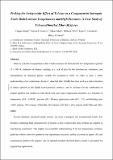| dc.contributor.author | Zhang, Yingjia | |
| dc.contributor.author | Somers, Kieran P. | |
| dc.contributor.author | Mehl, Marco | |
| dc.contributor.author | Pitz, William J. | |
| dc.contributor.author | Cracknell, Roger F. | |
| dc.contributor.author | Curran, Henry J. | |
| dc.date.accessioned | 2017-10-05T13:10:38Z | |
| dc.date.issued | 2016-07-12 | |
| dc.identifier.citation | Zhang, YJ,Somers, KP,Mehl, M,Pitz, WJ,Cracknell, RF,Curran, HJ (2017) 'Probing the antagonistic effect of toluene as a component in surrogate fuel models at low temperatures and high pressures. A case study of toluene/dimethyl ether mixtures'. Proceedings Of The Combustion Institute, 36 :413-421. | en_IE |
| dc.identifier.issn | 1540-7489 | |
| dc.identifier.uri | http://hdl.handle.net/10379/6868 | |
| dc.description.abstract | There is a dearth of experimental data which examine the fundamental low-temperature ignition (T < 900 K) behavior of toluene resulting in a lack of data for the construction, validation, and interpretation of chemical kinetic models for commercial fuels. In order to gain a better understanding of its combustion chemistry, dimethyl ether (DME) has been used as a radical initiator to induce ignition in this highly knock resistant aromatic, and its influence on the combustion of toluene ignition was studied in both shock tube and rapid compression machines as a function of temperature (624–1459 K), pressure (20–40 atm), equivalence ratio (0.5–2.0), and blending ratio (100% toluene, 76% toluene (76T/24D), 58% toluene (58T/42D), 26% toluene (26T/74D) and 100% DME).
Several literature chemical kinetic models are used to interpret our experimental results. For mixtures containing high concentrations of toluene at low-temperatures none of these are capable of reproducing experiment. This implies an incomplete understanding of the low-temperature oxidation pathways which control its ignition in our experimental reactors, and by extension, in spark- (SI) and compression-ignition (CI) engines, and an updated detailed chemical kinetic model is presented for engineering applications.
Model analyses indicate that although the initial fate of the fuel is dominated by single-step H-atom abstraction reactions from both the benzylic and phenylic sites, the subsequent fate of the allylic and vinylic radicals formed is much more complex. Further experimental and theoretical endeavors are required to gain a holistic qualitative and quantitative chemical kinetics based understanding of the combustion of pure toluene, toluene blends, and commercial fuels containing other aromatic components, at temperatures of relevance to SI and CI engines. | en_IE |
| dc.description.sponsorship | The work at NUI Galway was supported by the European Commission Marie Curie Transfer of Knowledge Scheme (FP7) pursuant to Contract PIAP-GA-2013-610897 GENFUEL. The work at Xi’an Jiaotong University was supported by the National Natural Science Foundation of China (No. 91541115). The work at LLNL was supported by the U.S. Department of Energy, Vehicle Technologies Office (program managers Gurpreet Singh and Leo Breton) and performed under the auspices of the U.S. Department of Energy by Lawrence Livermore National Laboratory under Contract DE-AC52-07NA27344. | en_IE |
| dc.format | application/pdf | en_IE |
| dc.language.iso | en | en_IE |
| dc.publisher | Elsevier | en_IE |
| dc.relation.ispartof | Proceedings Of The Combustion Institute | en |
| dc.rights | Attribution-NonCommercial-NoDerivs 3.0 Ireland | |
| dc.rights.uri | https://creativecommons.org/licenses/by-nc-nd/3.0/ie/ | |
| dc.subject | Shock tube | en_IE |
| dc.subject | Rapid compression machine | en_IE |
| dc.subject | Ignition delay time | en_IE |
| dc.subject | Toluene | en_IE |
| dc.subject | Dimethyl ether | en_IE |
| dc.subject | RAPID COMPRESSION MACHINE | en_IE |
| dc.subject | SHOCK-TUBE | en_IE |
| dc.subject | DIMETHYL ETHER | en_IE |
| dc.subject | ISO-OCTANE/AIR | en_IE |
| dc.subject | IGNITION DELAY | en_IE |
| dc.subject | AUTO-IGNITION | en_IE |
| dc.subject | OXIDATION | en_IE |
| dc.subject | PYROLYSIS | en_IE |
| dc.subject | AUTOIGNITION | en_IE |
| dc.subject | BENZENE | en_IE |
| dc.title | Probing the antagonistic effect of toluene as a component in surrogate fuel models at low temperatures and high pressures. A case study of toluene/dimethyl ether mixtures | en_IE |
| dc.type | Article | en_IE |
| dc.date.updated | 2017-10-03T07:45:40Z | |
| dc.identifier.doi | 10.1016/j.proci.2016.06.190 | |
| dc.local.publishedsource | https://doi.org/10.1016/j.proci.2016.06.190 | en_IE |
| dc.description.peer-reviewed | peer-reviewed | |
| dc.contributor.funder | |~| | |
| dc.description.embargo | 2018-07-12 | |
| dc.internal.rssid | 12333739 | |
| dc.local.contact | Henry Curran, Dept Of Chemistry, Room 215, Arts/Science Building, Nui Galway. 3856 Email: henry.curran@nuigalway.ie | |
| dc.local.copyrightchecked | No | |
| dc.local.version | ACCEPTED | |
| nui.item.downloads | 283 | |


